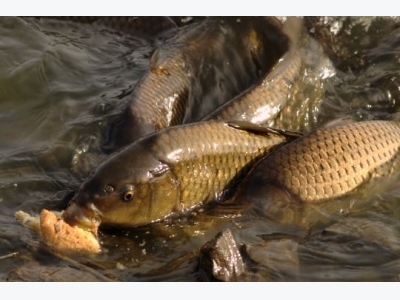Top tips from expert for cleaner fish feeding

Feeds and feeding techniques were amongst the key topics discussed at the International Cleaner Fish Summit in Glasgow.
Speaking at the second day of the event, Mads Lenes, cleanerfish coordinator at Marine Harvest Norway's most northerly sites, explained both the rationale for offering cleanerfish supplementary feeds and how the company’s feeding strategy was evolving.
“Unlike salmon, the cleanerfish are not fed primarily for growth,” he pointed out, “but mainly to ensure their maintenance and welfare”.
Lice do not have the right range of nutrients to keep cleanerfish healthy, Lenes observed, adding that it was essential to keep them healthy both from a welfare perspective and to make them as effective as possible as louse eaters.
One strategy he noted as making wrasse more effective, was to feed the salmon close to the artificial kelp hides in the cages, in order to shorten the distance between the wrasse and the salmon.
Another was to start to feed the wrasse as soon as they were deployed, “perhaps even overfeed by two of three times” to ensure they get a taste for the diets.
For lumpfish he recommended feeding rations equating to 2% of the biomass of the lumpfish in the cage, 4 days a week from December to May and 7 days a week from June to December.
He also stressed the importance of using the same diets in sea cages that were being used by the producers of the cleanerfish.
He revealed that, feeding the lumpfish at the same time as the salmon (ie for 3-6 hours a day), meant that “in theory the lumpfish can then spent the rest of the day hunting lice”.
While they generally use machines to distribute the feed automatically he recommended that each cage should be hand-fed once a week to allow site technicians to observe their feeding behaviour more closely, and he revealed that the company was just starting a trial alternating feeding between automatic feeders 80% of the time and hand-feeding the remaining 20%.
Meanwhile he recommended feeding wrasse at 1-2% of the biomass for 3-7 days a week, depending on temperature, and suggested a combination of automatic feeders and bait bags for farm-raised wrasse, and just bait bags for wild-caught.
Depite these guidlines, he admitted it was still an evolving art. “’How do we feed the cleanerfish?’ is still the most asked question at our sea sites,” Lenes reflected.
“It’s not easy to get the level right when you’re dealing with two species in the same cage and only 5-10% are cleanerfish,” he added.
Related news
 Shellfish sector must increase mussel mass
Shellfish sector must increase mussel mass A new study suggesting ways in which Scottish mussel growers can step up their production levels has been published today.
 Shrimp sector electrification to improve competitiveness
Shrimp sector electrification to improve competitiveness The search for efficient and sustainable aquaculture through the Electrification Plan for the Shrimp Sector is the objective of the cooperation
 Scientists continue study of black gill in shrimp
Scientists continue study of black gill in shrimp Black gill could be one of many factors contributing to a decline in commercial shrimp fishing, but there are other factors as well